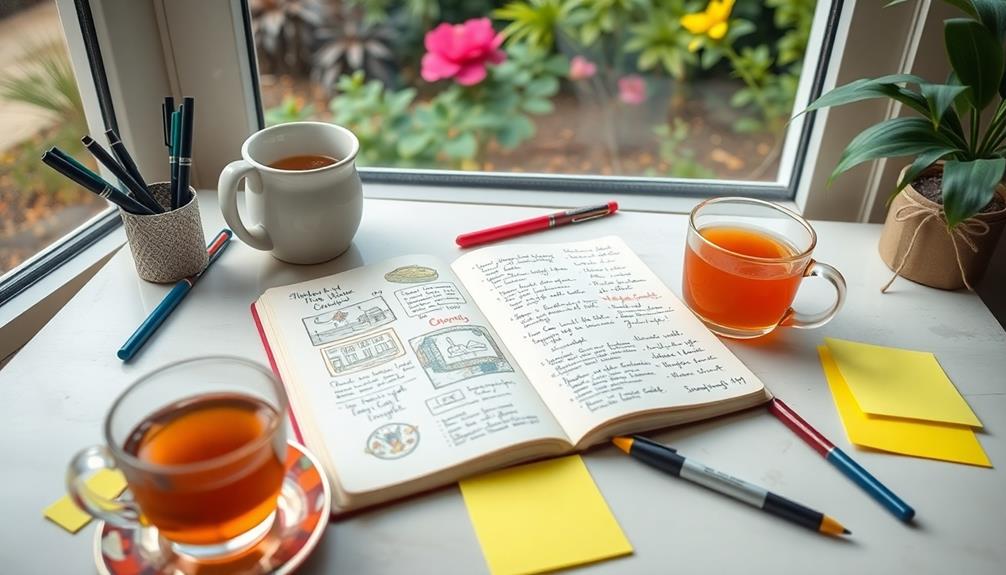To create a curiosity journal for self-reflection, start by choosing an A5 notebook with high-quality paper for smooth writing. Set a routine, picking a comfortable spot and time to jot down your thoughts. Use prompts to stimulate deeper reflection and incorporate doodles or mind maps to visualize your ideas. Organize your entries by numbering pages and creating a thematic index for easy navigation. Don't forget to revisit your journal monthly to track your growth and emotional patterns. Each entry helps you connect with your feelings and encourages self-discovery, inviting you to explore even more possibilities.
Key Takeaways
- Choose a durable A5 journal with high-quality paper for a smooth writing experience and portability.
- Establish a consistent journaling routine by selecting a specific time and comfortable environment for reflection.
- Incorporate thematic indexing and page numbering to improve organization and allow for easy retrieval of thoughts.
- Use prompts, quotes, and mind mapping to stimulate deeper exploration and capture complex ideas effectively.
- Regularly reflect on and revise entries to track emotional responses and insights, enhancing self-awareness.
Purpose of a Curiosity Journal

A curiosity journal is often a powerful tool for personal growth and exploration. Its primary purpose is to facilitate self-reflection, allowing you to dive deep into your thoughts and feelings. By regularly documenting your insights, you create a space for mindfulness and emotional awareness. This process of reflecting on your experiences can lead to significant personal growth, as you uncover patterns in your thoughts and behaviors.
Additionally, engaging in minimalist environments can support this introspective journey by promoting relaxation and clarity.
Moreover, a curiosity journal encourages continuous learning. As you jot down questions and areas of interest, you cultivate an appetite for knowledge that extends beyond the pages of your journal. This habit not only enriches your understanding of various subjects but also fosters intellectual growth.
Engaging with your curiosity journal can enhance your creative problem-solving skills. You'll find that brainstorming in this safe environment allows you to experiment with ideas without fear of judgment.
Additionally, keeping track of your entries lets you monitor your personal growth over time, influencing future projects and decisions.
In essence, a curiosity journal serves as a valuable resource for self-discovery, empowering you to embrace continuous learning and ultimately achieve your personal growth goals.
Essential Materials Needed

When creating your curiosity journal, you'll want to choose an A5 size for portability and ease of use.
Opt for high-quality paper, like Tomoe River, to guarantee a smooth writing experience without ink bleed.
Don't forget to contemplate customizing your journal with inserts, which can really spark your creativity.
Journal Size and Material
Your curiosity journal's size and material play an essential role in its usability and durability. An A5 journal size is highly recommended for portability, making it easy to carry and use in various settings. This compact size helps you jot down your thoughts whenever inspiration strikes, whether you're at a café or on the go.
Durable materials are vital for ensuring your journal can withstand daily wear and tear, especially if you plan to travel with it.
If you're feeling creative, consider DIY assembly using loose A4 sheets and a soft cardboard cover. This approach allows for customization and helps you understand your personal preferences better. You can mix and match content types, incorporating poetry or sketches, which enriches your journal's content and encourages diverse forms of expression.
For a smooth writing experience, think about using Tomoe River 68 GSM paper. It's fountain pen compatible and prevents bleed-through, so your ideas stay clear and legible.
Paper Quality Considerations
Quality matters when it comes to selecting paper for your curiosity journal. The right paper can elevate your writing experience and help preserve your thoughts over time.
For instance, Tomoe River 68 GSM paper is an excellent choice due to its fountain pen compatibility and smooth writing surface. This type of paper minimizes bleed-through and feathering, ensuring that your reflections remain clear and legible.
Additionally, engaging in self-reflection through journaling can enhance emotional resilience, aiding in coping with challenges as mentioned in the Power of Imagination.
When choosing your journal, consider the following essential materials:
- A5-sized journals: They're portable and perfect for on-the-go reflection.
- Durable cover materials: A sturdy cover enhances longevity, making your journal resilient against travel wear and tear.
- Loose A4 sheets: These provide flexibility for adding or rearranging content, catering to various journaling styles.
Investing in high-quality paper not only enhances your writing experience but also encourages you to engage deeply with your thoughts.
Customization and Inserts Options
A variety of customization options can transform your curiosity journal into a personal reflection space that truly reflects your interests.
Start with a durable A5-sized cover; it's portable and can withstand wear and tear during your travels. For the pages, choose high-quality Tomoe River 68 GSM paper, which pairs perfectly with fountain pens, ensuring smooth writing and minimal bleed-through.
Incorporating self-care practices, such as journaling, can enhance your overall well-being and mental clarity, making your journal even more valuable self-care practices.
Incorporate multiple inserts, like loose A4 sheets, to diversify your content. These sheets can hold poetry, sketches, or notes from various sources, allowing you to express yourself in different formats.
To keep everything organized, think about adding an index system. Number your pages and use index cards to list related topics, making retrieval a breeze.
Techniques for Capturing Information

To effectively capture information for your curiosity journal, focus on synthesizing key highlights from your reading materials. This means pulling quotes, notes, and your personal interpretations together, creating a rich resource for future reference.
Consider these techniques to enhance your entries:
- Transcribe key ideas from podcasts: This helps reinforce your retention and facilitates deeper reflection on what you've learned.
- Use doodling and mind mapping: Visually representing concepts can make complex ideas more accessible and enjoyable to engage with.
- Incorporate prompts for reflection: Stimulate your thoughts by sketching or doodling, allowing for a unique visual expression of your interests and experiences.
Organizing Your Journal

To keep your curiosity journal organized, start by numbering your pages and creating a thematic index.
This system makes it easy to find specific topics and insights when you need them.
Page Numbering System
Numbering each page of your curiosity journal creates an organized structure that makes navigation effortless. By sequentially numbering your pages, you'll have a clear path to follow as you reflect and explore your thoughts.
It's important to choose a consistent format for numbering, whether you place the numbers in the top corner or the bottom. This uniformity helps maintain a clean appearance throughout the journal.
To enhance your organizational system, consider these tips:
- Create an index at the beginning or end of your journal that lists topics alongside their corresponding page numbers.
- Update the index regularly as you add new entries, ensuring each topic is accurately reflected for easy access.
- Stick to a single numbering system to prevent scattering content across multiple journals.
With these strategies in place, you'll streamline your reflection process and make it easier to revisit your insights.
A well-organized journal not only helps you find information quickly but also encourages you to engage more deeply with your thoughts. Following this page numbering system will set a solid foundation for your curiosity journal.
Thematic Indexing Method
As you dive deeper into your curiosity journal, implementing a thematic indexing method can greatly improve how you organize your thoughts.
Start by numbering each page and creating an index that categorizes your topics for easy retrieval. This way, you can navigate your entries efficiently, saving time as you revisit your reflections.
Use index cards to list related page numbers under specific themes. This practice helps maintain organization and prevents scattering of content across multiple journals.
Focus on topic-based learning by summarizing key insights and reflections for each theme. This approach facilitates a deeper exploration of related ideas and experiences, enriching your self-reflection process.
As your journal expands, consider digitizing your indexing system to enhance accessibility and streamline content management.
Regularly update your index as you add new entries to guarantee it remains thorough and reflective of your evolving interests.
Reflecting and Revising Content

Reflecting on your curiosity journal can reveal deeper insights and foster personal growth. To get the most out of this process, schedule monthly revisits to evaluate how you've applied your curiosity in various projects. By setting aside dedicated time for reflection, you create a structured approach that helps you stay intentional and focused.
During each revision, utilize prompts and guiding questions to stimulate deeper exploration of your thoughts and feelings. Document any changes in perspective or new insights that arise; this allows you to track your personal growth over time. Celebrate milestones and progress identified during these sessions to maintain motivation.
Here are some strategies to enhance your reflection process:
- Use specific prompts like "What surprised me this month?" to guide your thinking.
- Make notes on any shifts in your perspective that occurred as you reflected.
- Acknowledge and celebrate even small achievements to keep your enthusiasm alive.
Establishing a Journaling Routine

To maximize the benefits of your curiosity journal, establishing a consistent journaling routine is key. Start by selecting a specific time for your journaling, whether it's in the morning or evening. This helps create a habitual routine that aligns with your natural rhythms.
Aim for a repeatable schedule that feels manageable—daily, weekly, or monthly—to cultivate a sustainable practice.
Next, choose a comfortable and inviting environment for your journaling sessions. Incorporate elements that promote relaxation, like good lighting and cozy seating, while minimizing distractions. Making your space enjoyable enhances your motivation to journal regularly.
Add personal touches to your journaling to make it more engaging. Experiment with colorful pens, stickers, or art supplies to spark your creativity. This not only makes the process fun but also encourages you to explore your thoughts more freely.
Engaging With Emotions

Engaging with emotions in your curiosity journal opens up a pathway to deeper self-understanding and personal growth. Instead of just recording intellectual thoughts, you'll want to immerse yourself in your emotional responses to experiences. Acknowledge feelings like joy, sadness, or surprise; this fosters emotional awareness and enriches your reflection process.
To enhance your emotional engagement, consider these practices:
- Pull introspective questions: Ask yourself what emotions arise during significant moments and why.
- Practice self-empathy: Allow yourself to sit with your emotions without judgment. This strengthens your connection to your feelings.
- Identify patterns: Regularly revisit your entries to recognize recurring emotional themes and responses.
Additional Resources and Tools

When you're ready to explore deeper into your curiosity journal practice, a variety of resources and tools can enhance your experience. Workshops like "Unlocking The Power of Empathy" can teach you techniques to connect with emotions through guided journaling exercises. You might also find Actually Curious tools helpful, as they offer prompts and questions designed to deepen self-reflection.
Incorporating mindfulness practices can cultivate awareness of pleasant moments, enriching your journal entries. Reflection.app is another excellent resource, providing structured journaling prompts and insights for personal development. Additionally, diving into books and articles about the benefits of self-reflection can further empower your journaling journey.
Here's a quick reference table to help you choose the right tools:
| Resource/Tool | Purpose |
|---|---|
| Workshops | Techniques for emotional connection and journaling |
| Actually Curious | Prompts for self-reflection and emotional awareness |
| Mindfulness Practices | Cultivating awareness of positive experiences |
| Reflection.app | Structured prompts for personal development |
| Books/Articles on Journaling | Insights on self-reflection benefits and techniques |
Utilizing these resources can elevate your curiosity journal practice greatly.
Frequently Asked Questions
How to Write a Self-Reflection Journal?
To write a self-reflection journal, set aside at least five minutes daily.
Focus on your thoughts and feelings, and use guiding questions like, "What did I learn today?" This helps deepen your understanding.
Document your reflections clearly, making it easier to review later.
Consider using mind maps or doodles to visually capture your insights.
How to Write a Self-Awareness Journal?
To write a self-awareness journal, start by carving out daily time in a quiet space to reflect on your thoughts and feelings.
Ask yourself guiding questions like, "What am I feeling right now?" and "What triggered this emotion?" Document key experiences and their emotional impacts, noting any patterns.
Use mindfulness to observe your thoughts without judgment, and make it a habit to review your entries regularly to track your growth and identify improvement areas.
How to Make a Self-Discovery Journal?
"Curiosity killed the cat, but satisfaction brought it back."
To make a self-discovery journal, start by choosing a durable, portable journal. Use prompts to explore your thoughts deeply, and don't shy away from sketches or poetry.
Set a regular journaling schedule, and create an organized system with page numbers and an index. This way, you can easily revisit your insights and track your growth over time, fueling your journey of self-exploration.
How Do You Create a Self Development Journal?
To create a self-development journal, start by choosing a journal that feels right for you, like an A5 size with quality paper.
Set a regular time to write; consistency builds habit. Use techniques like mind mapping or doodling to explore your thoughts deeply.
Make your journaling space inviting and free from distractions.
Conclusion
Creating a curiosity journal isn't just about recording thoughts; it's like planting seeds in a garden. Each entry is a seed of exploration that, with care and reflection, can bloom into profound insights. Just like a gardener tends to their plants, nurturing your curiosity daily leads to vibrant self-discovery. So grab your pen and start cultivating your inner landscape; you never know what beautiful thoughts might sprout when you give them a little attention.









